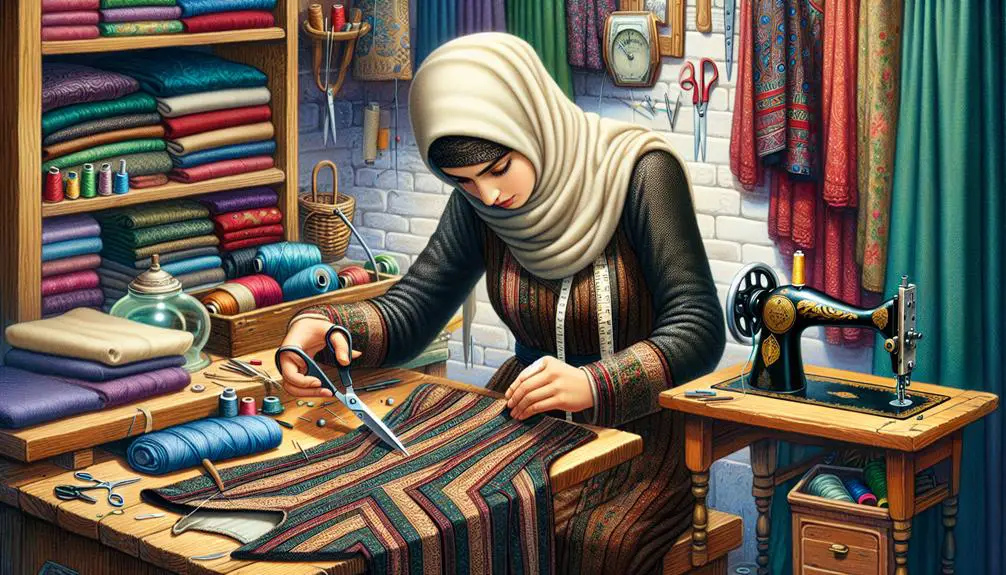Imagine your favorite dress, snug in some areas but just a bit too tight overall. Can a tailor work their magic, breathing new life into it?
The answer might surprise you. Tailors possess the skill to expand your beloved garment, offering a tailored fit that feels like a second skin. But how exactly do they accomplish this transformation, and what are the limitations?
Let's explore the art of tailoring and the possibilities it holds for your wardrobe.
Table of Contents
Key Takeaways
- Skilled tailors can enlarge a dress by 1-2 inches without compromising its design integrity.
- Fabric considerations are crucial to prevent damage or puckering during size adjustments.
- Tailors employ creative solutions like adding fabric strategically to maintain the original dress style.
- Professional tailoring services ensure customer satisfaction with personalized, flattering alterations.
Tailor's Ability to Make a Dress Bigger
Skillful tailors possess the expertise to effectively increase the size of a dress by 1-2 inches, ensuring a comfortable and flattering fit for the wearer. One key technique they use is adjusting the seam allowance. By carefully altering the seams of a dress, tailors can add extra fabric strategically where needed without compromising the overall design. This method allows for a seamless enlargement of the garment while maintaining the original aesthetic.
When it comes to altering a dress, adding extra fabric is another tool in a tailor's arsenal. Whether it's expanding the underarms or letting out the waist, incorporating additional material requires precision and skill. Tailors can expertly blend the new fabric with the existing one, ensuring a cohesive look that doesn't appear patched together.
In my experience, I've seen how professional tailors can work wonders with intricate alterations. From adding zippers to modifying seams, these experts know how to enlarge a dress effectively while preserving its original charm. Their attention to detail and craftsmanship ensure that the end result is a perfectly tailored garment that fits like a dream.
Understanding Fabric Limitations for Alterations
When considering alterations for garments, it's important to understand the limitations that different fabrics present, as they can impact the outcome of the tailoring process. Here are some key points to keep in mind:
- Needle Holes Visibility: Fabrics like satin and taffeta may show needle holes more prominently after alterations, affecting the overall appearance of the garment.
- Thread Concealment: Fabrics such as velvet, polyester, and cotton tend to hide sewing thread well during alterations, providing a more seamless finish.
- Seam Adjustments: Seam adjustments must be carefully considered based on the condition and type of fabric to prevent damage or puckering along the side seams.
- Hem Stitching: It's crucial to stitch hems back accurately after altering to maintain the garment's integrity and ensure a professional look using a sewing machine.
Understanding these fabric limitations is crucial for a successful alteration process that preserves the garment's quality and appearance.
Techniques for Increasing Dress Size
To increase the size of a dress, tailors can effectively add extra fabric on each side for a more comfortable and flattering fit. This technique is particularly useful for simple-cut summer dresses, allowing for adjustments of one or two sizes up. By revamping the design with added fabric, dresses can be given a fresh and updated look. This alteration method is especially beneficial for bargain garments purchased on sale, offering a cost-effective solution to make your dress bigger while enhancing its overall appearance.
| Benefits of Adding Extra Material | Description |
|---|---|
| Comfortable Fit | Additional fabric provides more room and flexibility. |
| Flattering Appearance | Enhances the silhouette and makes the dress more flattering. |
| Cost-Effective Solution | A budget-friendly way to modify the size of your dress. |
Adding Fabric Through Creative Solutions
So, let's talk about adding fabric to make a dress bigger.
This creative solution involves expanding the garment strategically to cater to different sizes.
Fabric Expansion Techniques
Exploring innovative ways to expand fabric creatively in dress alterations can breathe new life into your wardrobe. When it comes to adding fabric for a better fit, focusing on the sides can make a significant difference. Here are some techniques to consider:
- Side Expansion: Tailors can skillfully add fabric on each side of a dress to increase its size comfortably.
- Simple-cut Dresses: Summer dresses with straightforward designs can easily be adjusted for one or two sizes up by introducing additional fabric.
- Revamping Style: By incorporating extra fabric, dresses can be given a fresh new look and style, making them feel like entirely new pieces.
- Resizing Bargain Garments: This technique is ideal for resizing bargain dresses bought on sale, offering a cost-effective way to tailor your wardrobe.
Tailoring for Size
Considering the fabric expansion techniques discussed previously, one effective way to tailor a dress for size is by skillfully adding fabric through creative solutions. By incorporating extra fabric on each side of the dress, a tailor can successfully make the garment bigger while maintaining its original style and shape.
This approach works particularly well for simple-cut summer dresses, allowing for adjustments of one or two sizes up. Not only does adding fabric enhance the overall fit, but it also provides an opportunity to revamp the design, giving the dress a fresh and updated look.
This method is ideal for bargain dresses purchased on sale that require size modifications, offering both comfort and style for those looking to make their dresses bigger.
Innovative Alteration Methods
When tailoring a dress for a larger size, a skilled tailor can ingeniously incorporate additional fabric to enhance both comfort and style. Here are some innovative alteration methods that professional tailors use to alter your dress by adding fabric:
- Strategic Fabric Placement: Tailors can strategically add fabric in key areas to expand the size while maintaining the original design.
- Revamped Design: Innovative alteration methods involve revamping the dress design by creatively incorporating extra fabric.
- Enhanced Appearance: Adding fabric through creative solutions can give the dress a fresh look and enhance its overall appearance.
- Seamless Integration: Tailors implement unique techniques to seamlessly integrate the added fabric with the existing design, ensuring a cohesive and stylish result.
Utilizing Seam Adjustments for a Larger Fit
Through strategic unpicking of seams and thoughtful adjustments, I can effectively create a larger fit for a dress. Seam adjustments are a key technique in altering the size of a dress. By carefully unpicking and re-stitching seams, I can add extra width or room to accommodate the desired fit. Seam allowances are vital in this process, as they provide the necessary fabric for adjustments without compromising the overall structure of the dress.
In cases where more significant modifications are needed, adding zippers or extra fabric to the seams can be a practical solution. This method allows for a more seamless enlargement of the dress while maintaining its original design and integrity. However, it's essential to assess the fabric's condition before making extensive seam adjustments to ensure the dress retains its quality and durability.
Once the necessary alterations are made, properly stitching hems is crucial to achieve a clean and professional finish. Attention to detail in the finishing touches ensures that the dress not only fits beautifully but also looks impeccably tailored.
Tailoring Options for Different Dress Types
For different types of dresses, tailors offer a range of options to achieve the perfect fit. When it comes to altering dresses, especially intricate pieces like wedding gowns, tailors can work wonders to ensure a flawless fit. Here are some tailoring options tailored to different dress types:
- Wedding Dresses: Wedding dresses often require precise adjustments, particularly around the bust line. Tailors can skillfully alter the bust area to provide the necessary support and shape for a bride's special day.
- Underarm Panels: Adding underarm panels is a common technique used by tailors to increase the overall size of a dress without compromising the original design. This method is particularly useful for formal dresses that require a seamless enlargement.
- Extenders: Tailors can also incorporate extenders into dresses to increase their size by 1 to 2 inches comfortably. This method works well for various dress lengths, including long, midi, and mini styles.
- Expert Advice: Seek guidance from experienced tailors when dealing with challenging alterations. Their expertise can help navigate complex adjustments and ensure a successful outcome for your enlarged dress.
Factors Affecting Successful Dress Enlargement
As we shift our focus to discussing the factors influencing successful dress enlargement, it becomes evident that the expertise of the tailor plays a crucial role in achieving a seamless and comfortable fit. When aiming to make a dress bigger, it's essential to consider the original size of the dress. Generally, a skilled tailor can increase a dress size by 1 to 2 inches while maintaining the dress's overall integrity. Taking the dress in at the seams allows for adjustments that can make a dress smaller or larger, depending on the desired outcome.
Moreover, the type of dress also influences the feasibility of enlargement. For instance, formal dresses like wedding gowns often offer more flexibility for adjustments due to their construction and design. Additionally, when dealing with challenging areas like underarms, a skilled tailor can strategically add extra fabric to ensure a comfortable and flattering fit. Trusting experienced tailors with the task of enlarging a dress is key to achieving the desired results without compromising the garment's original shape or style.
Tailor's Role in Preserving Dress Integrity
I'll start by highlighting the essential role that tailors play in maintaining a dress's integrity when adjusting its size.
Tailors use specific techniques to ensure that the fabric they add matches seamlessly with the original material, preserving the dress's overall look and feel.
Size Adjustment Techniques
A tailor skillfully adjusts dress sizes by adding fabric on each side, preserving the garment's integrity and ensuring a comfortable and customized fit. When altering a dress to fit, especially by adding fabric to the side of the dress, it's crucial to be extra careful to maintain the original design. Here are some key points to consider:
- Custom Fit: By strategically adding fabric, tailors can adjust the dress size to fit the individual's measurements perfectly.
- Preservation of Design: The added fabric allows adjustments of up to one to two sizes larger while keeping the dress's original style intact.
- Revamped Look: This technique not only increases the size but also gives the dress a fresh appearance, breathing new life into the garment.
- Ideal for Bargains: Perfect for altering sale finds that need size adjustments without compromising the dress's integrity.
Fabric Matching Considerations
When expanding a dress size through fabric matching, a tailor's careful selection of matching fabric types, colors, and textures plays a pivotal role in preserving the garment's integrity. Attention to detail in fabric matching is essential to ensure a seamless enlargement that seamlessly blends with the original material. Tailors consider factors like the weight and stretch of the fabric to achieve a professional and cohesive result. For instance, when enlarging a dress made of cotton, matching it with a similar cotton fabric ensures consistency in both look and feel. Similarly, if the original dress is crafted from linen, selecting a matching linen fabric maintains the overall aesthetic of the garment. This meticulous approach to fabric matching is crucial for maintaining the dress's original charm and style.
| Fabric Type | Matching Consideration |
|---|---|
| Cotton | Match with similar cotton fabric for consistency in look and feel. |
| Linen | Select a matching linen fabric to preserve the original aesthetic. |
Addressing Specific Areas for Size Adjustment
To make a dress bigger, specific areas such as the bust, waist, hips, and sleeves can be tailored for size adjustments. Here are some methods for addressing these areas:
- Bust Enlargement: Tailors can add diamond gussets to the side seams of the dress to accommodate a larger bust size effectively.
- Waist Adjustments: Waist alterations may involve letting out darts in the bodice or replacing existing elastic with a larger one to increase comfort and fit.
- Hip Expansion: Adding panels or godets to the side and back seams of the dress can help enlarge the hip area without compromising the overall look.
- Sleeve Fit: Evaluating sleeve fit is crucial; solutions like adding gussets can effectively address tight sleeves, ensuring freedom of movement and comfort.
Considerations When Altering Evening Gowns
Considering the intricacies of evening gowns, it's vital to understand the specific considerations when altering these garments to ensure a flawless fit and preservation of their elegance. Tailors play a crucial role in adjusting evening gowns made of delicate fabrics like silk or chiffon. These fabrics require skilled handling to maintain their integrity during alterations. When it comes to intricate details such as beadwork, sequins, or elaborate designs, tailors must exercise precision and expertise to ensure these elements are preserved or seamlessly integrated into the alterations.
Moreover, evening gowns with intricate draping or pleating demand meticulous attention to detail. Alterations to these features must be carried out with care to uphold the garment's original elegance. Consulting with a professional tailor experienced in working with formal wear is highly recommended to navigate the complexities of altering evening gowns successfully. By entrusting these delicate tasks to skilled professionals, you can rest assured that your gown will be tailored with the utmost care and expertise.
Balancing Aesthetics With Garment Functionality
Strategically adding fabric in key areas allows tailors to make a dress bigger while maintaining its aesthetic appeal. When balancing aesthetics with garment functionality, certain considerations are paramount:
- Seamless Integration: The added fabric should seamlessly blend with the original design, ensuring that the alterations go unnoticed.
- Enhanced Look: Careful placement of additional fabric can enhance the overall appearance of the dress, elevating its aesthetic appeal.
- Techniques for Expansion: Tailors can employ techniques like creating diamond gussets or side panels to expand the dress effectively without compromising its visual appeal.
- Harmonious Balance: The ultimate goal is to find a harmonious balance between enlarging the dress for a better fit and preserving the original design elements intact.
Even though size adjustments are necessary, the dress still needs to look as if it was always the perfect fit. Required fields are marked to ensure that each adjustment contributes to the overall aesthetic of the garment.
Customer Satisfaction Through Tailored Solutions
Tailors cater to customer satisfaction by providing tailored solutions that enhance the fit and comfort of dresses through expert alterations. When it comes to dress enlargement, skilled tailors can increase sizes by 1-2 inches, focusing on areas like the bust, waist, hips, and back. By offering customized solutions such as adding extra fabric, panels, or gussets, tailors ensure that dresses are made bigger without compromising their original design. Assessing the feasibility of enlargement based on fabric type, style, and construction, professional tailors guarantee a comfortable and flattering fit for customers. This attention to detail results in customer satisfaction through personalized alterations that meet individual needs and preferences. Below is a table showcasing the various aspects of tailored solutions for dress enlargement:
| Tailored Solutions | Expert Alterations | Customer Satisfaction |
|---|---|---|
| Increase dress sizes | Add extra fabric | Comfortable fit |
| Focus on key areas | Create additional panels | Flattering look |
| Assess feasibility | Maintain original design | Personalized service |
| Enhance fit and comfort | Preserve garment integrity | Individual preferences |
Frequently Asked Questions
How Much Does It Cost to Make a Dress Bigger?
Making a dress bigger can cost between $20 to $100, depending on the complexity. Simple alterations like adding fabric to side seams may be cheaper. Consult with a tailor to get an accurate estimate based on your dress and needs.
Can You Make a Dress Bigger if It's Too Small?
Yes, I can expand a dress that's too small by adding fabric, adjusting seams, or extending the hemline. Tailoring techniques like inserting panels or altering closures can effectively increase the size of the dress.
How Long Does It Take for a Seamstress to Make a Dress Bigger?
Timing for dress enlargements varies; simple fixes like letting out seams take a few hours, while complex redesigns could span a day. Fabric type, dress intricacy, and tailor's workload affect alterations. Consultation beforehand is wise for planning.
How Many Sizes up Can a Dress Be Altered?
Altering dresses can generally increase the size by 1 to 2 sizes up, but fabric constraints play a role. Cotton and linen are easier to adjust compared to chiffon or organza. Seeking professional help for significant alterations is advisable.
- Why Is Red Velvet Not Red? - April 25, 2024
- How Do You Describe Velvet Fabric? - April 25, 2024
- How Strong Is Velvet? - April 25, 2024








